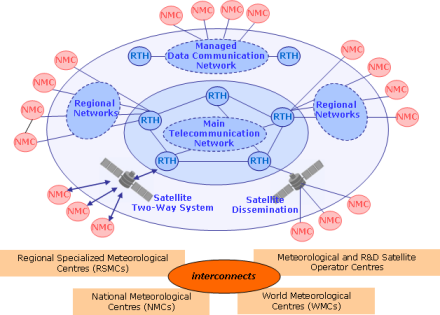Global Telecommunication System (GTS)
Please note that as of January 2025 the GTS-to-WIS2 transition phase has started
Migration from GTS to WIS2 is planned to occur between 2025 and 2033.
The GTS is planned to be decommissioned by 2033.
As per Resolution 16 of EC-78: "the Manual on the Global Telecommunication System (WMO-No. 386) will no longer be updated from 31 December 2024"
For more information see: https://community.wmo.int/en/GTS_WIS2_Transition_Guidance
| The Global Telecommunication System (GTS) is "The co-ordinated global system of telecommunication facilities and arrangements for the rapid collection, exchange and distribution of observations and processed information within the framework of the World Weather Watch." |
WMO No 49 Technical Regulations |
 |
The functions of the Global Telecommunication System (GTS) as a key component within the WMO Information System (WIS) shall be to facilitate the flow of data and processed products to meet the WWW requirements in a timely, reliable and cost-effective way, ensuring that all Members have access to data and products in accordance with approved procedures and within the limits of the agreed WWW system.
It also gives telecommunication support to other programmes as a part of WIS and as decided by the WMO Congress or the Executive Council, within the limits of its primary objectives.
Organizational principles of the GTS
The Global Telecommunication System shall be so organized as to accommodate the volume of meteorological information and its transmission within the required time limits as the core network of WIS and to meet the needs of World, Regional Specialized and National Meteorological Centres, resulting from the implementation of the WWW.
The GTS shall be organized on a three-level basis, namely:
(a) The Main Telecommunication Network (MTN), linking together the WMCs as well as designated Regional Telecommunication Hubs (RTHs);
(b) The regional telecommunication networks; and
(c) The national telecommunication networks.
Design principles of the GTS
The Global Telecommunication System shall be designed as an integrated network for the collection, exchange and distribution of information on a worldwide basis, with a view to meeting, efficiently and effectively, the requirements of all National Meteorological Services and also the requirements of World and Regional Specialized Meteorological Centres, within the agreed WWW system.
The GTS is an integrated network of surface-based and satellite-based telecommunication links of point-to-point circuits, and multi-point circuits, interconnecting meteorological telecommunication centres operated by countries for round-the-clock reliable and near-real-time collection and distribution of all meteorological and related data, forecasts and alerts. This secured communication network enables real-time exchange of information, critical for forecasting and warning of hydrometeorological hazards
